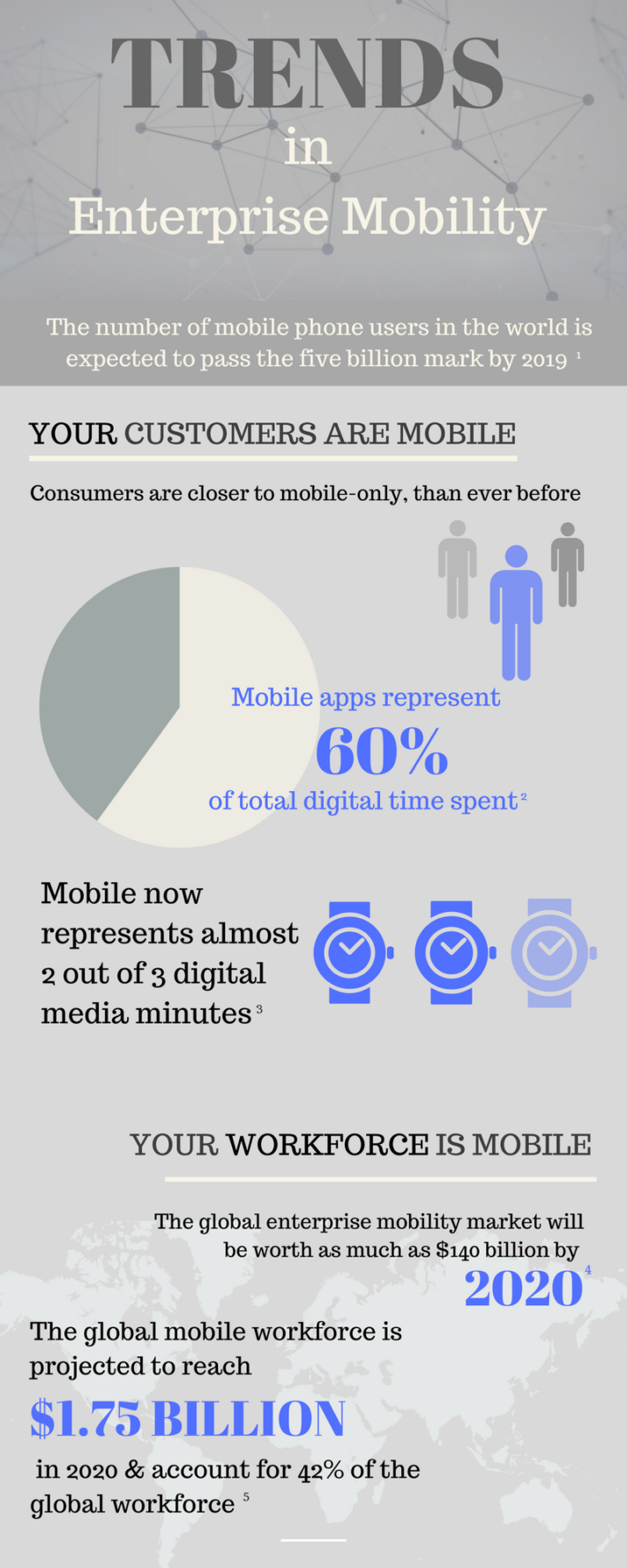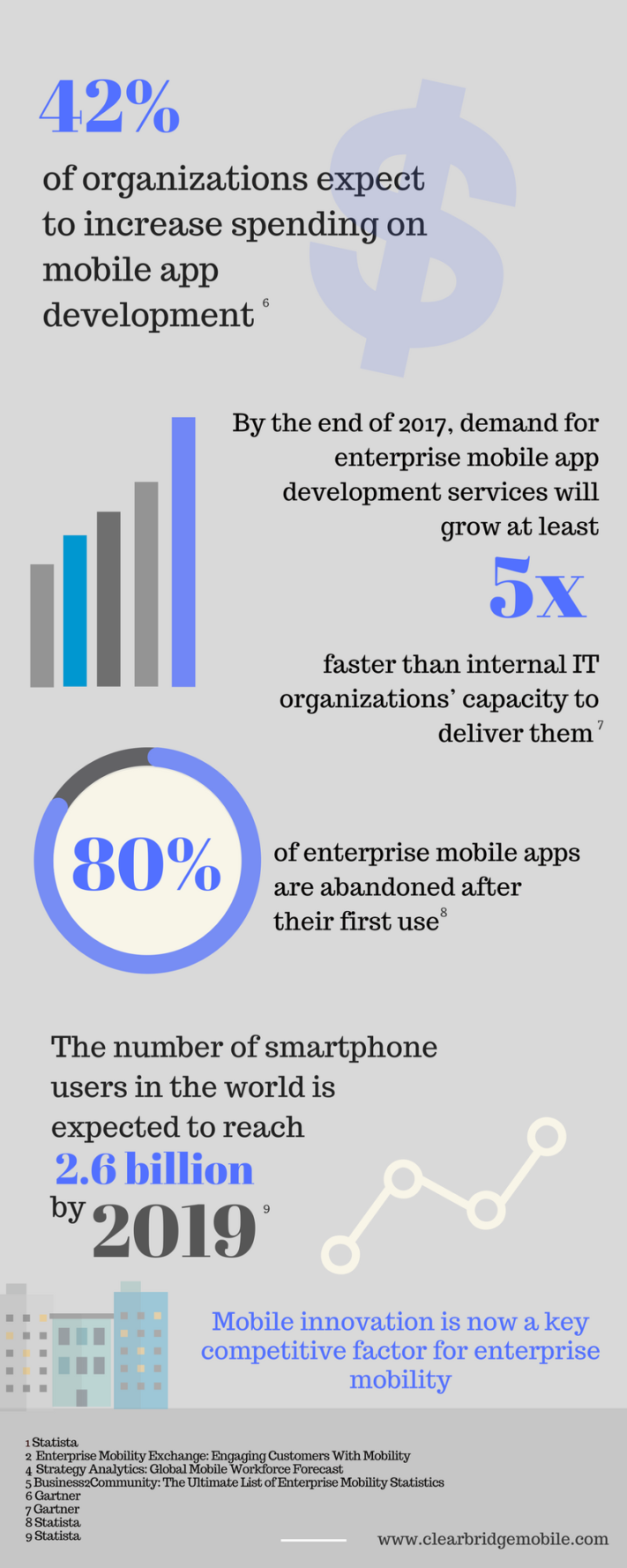Enterprise mobility has been on the radar of organizations for a while, yet for many, it has been a roadmap item rather than a priority. Mobile projects have been delayed, viewed as unimportant, or deemed “nice-to-haves.”
Moving into 2017, there’s a new sense of urgency. Enterprises are no longer just in competition with other large enterprises, but increasingly with mobile-first companies that are disrupting industries and capturing market share. New competition is coming from everywhere at a frenetic pace. These fast-moving, agile startups have less red tape, mobile-first products and services, and mobile workforces available at the tap of a button: and they are coming after your customers.
In today’s market, enterprises must put mobile top of mind, or risk being blindsided and losing market share. This post will provide an overview of the enterprise mobility landscape and the challenges organizations are facing as they adapt to the rapidly evolving mobile ecosystem.
Trends in Enterprise Mobility
Enterprise mobility is fast becoming a top priority for large organizations, both for workforce mobilization and customer engagement. Driving greater efficiencies and ROI, as well as connecting with a mobile customer base that is being targeted by mobile-first disruptors has placed both employee- and customer-facing enterprise mobile apps on the radar of enterprises that view mobile innovation as a key competitive factor. Below is an infographic of the emerging trends in enterprise mobility:
Prioritizing Mobile App Development
A recent Gartner study found enterprise spending on mobile app development has remained low, accounting for just 10% of overall application development budgets. However, with competition coming from all angles and attitudes toward the urgency of mobile shifting, both budgets and focus are changing. The same study revealed that 42% of organizations expect to increase spending on mobile app development, with 31% expected increase spending on mobile development in the coming year.
Enterprise Mobility Has Proven ROI
IBM Institute For Business Value found that 62% of IT leaders with a well-defined mobile strategy achieve ROI in 12 months or less, while VMWare’s State of Business Mobility Report already have an average of 150% reported ROI on business mobility investments. In fact, organizations that have achieved their business mobility goals were able to bring new revenue streams online 35% faster than companies that only focused on individual productivity needs.
Challenges Still Remain
Resourcing and Capabilities
Capabilities and resourcing are among the most pressing challenges for enterprise app development and deployment. Enterprise organizations typically don’t possess the capabilities for mobile in-house, and increasingly have to compete for talent with the very mobile-first startups that are challenging their business. In fact, Gartner’s CIO Survey found that lack of guidance to help identify and source the required roles and skills needed to create mobile apps was one of the top priority issues identified.
“As a result of having fallen into app development as a business necessity, organizations are typically lacking in basic app development life cycle skills such as user experience (UX) design, quality assurance, mobile-specific back-end data integration and mobile-oriented security needs” – Gartner, How To Build A Successful Mobile App Development Team
Legacy Systems & Security
Legacy systems continue to be a major challenge to organizations across the enterprise space. Emerging, mobile-first competitors have a significant advantage in that they don’t face the same legacy system issues and in many cases have less complex security challenges than their enterprise counterparts.
Recommendations For Moving Forward
Legacy Systems
Legacy systems exist everywhere; the major challenge is interfacing with them and figuring out how to pull the right data from them. Where enterprises tend to struggle is finding a way to take legacy systems that have been created for disparate purposes, centralizing them, and allowing people across the organization to interface with them.
The best solution when facing this challenge is creating an API layer that sits on top of the legacy systems, which allows centralization. This layer speaks to the legacy systems so that the systems and data are available to various facets of the business; anyone who needs to can communicate with the legacy systems through the API layer. Creating an API layer also allows organizations to choose what they expose so they can allow different groups – employees, partners, customers, etc. – to access specific subsections of the systems based on their needs.
Security
Security should be an underlying aspect of your holistic mobile strategy. While enterprise mobile security can be a complex issue to tackle, there are a number of focus areas that can lay the foundation for securing sensitive data and systems. If you are using a bring your own device (BYOD) model, a Mobile Device Management (MDM) solution, like SOTI or Airwatch, is essential. These solutions create a sandbox where your enterprise apps live, let you set compliance requirements, remotely wipe data, and more.
If your organization is issuing the devices, you have much more control over what employees can access on the devices and limit how the device is used. For example, you can disable native apps, force the use of whitelisted apps, have remote device locking functionality, and more. Data encryption, certificate underpinning, and strong authentication measures are also imperative to a well-rounded mobile security strategy and are typically part of MDM solutions. Importantly, your applications security strategy should be formalized and presented early in the development lifecycle, rather than a consideration that is addressed in later stages.
Mobility is now crucial for enterprises in order to avoid the risk of becoming obsolete. Mobility is a transformative trend which will help make organizations much more competitive and successful in the market. Driving greater efficiencies and ROI, and connecting with an increasingly mobile customer base has placed enterprise mobile apps on the radar of enterprises that recognize mobile innovation as a key competitive factor.
Download the full version of the 2017 Enterprise Mobile App Report:










